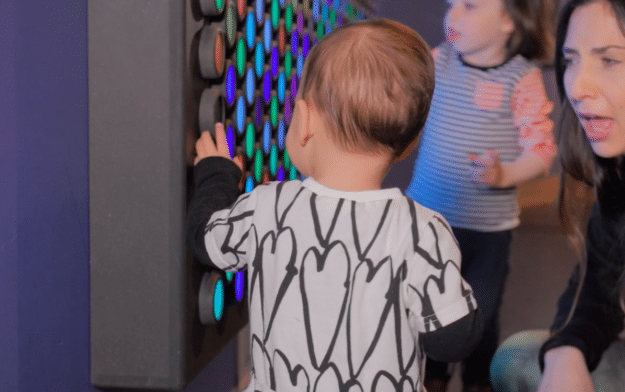
Many people think of creativity as a localized function of the mind, separate from the body. But researchers believe that from our earliest beginnings, creativity began in the body, and more specifically in the hands. As Juhani Pallasmaa writes in The Thinking Hand, “The amazing mobile versatility, learning capacity, and apparently independent functions of the hand may not be a result of the development of the human brain capacity, as we tend to think, but the extraordinary evolution of the human brain may well have been a consequence of the evolution of the hand.” He cites Marjorie O’Rourke, who notes, ‘Aristotle erred in asserting that humans had hands because they were intelligent, Anaxagoras was, perhaps, more correct in stating that humans were intelligent because they had hands.’ [11]
Hands activate creativity.
Designers who understand this principle will seek out ways to incorporate touch and hand gestures into a shared space.
Why does using the hands accelerate thinking and learning?
Creativity and thought are the result of a fusion between hand, eyes, and mind. Humans think with our hands. We express with our hands. We need to gesture.
Manipulating an object with the hands, while looking at it with the eyes, is highly engaging for the brain. As Frank R. Wilson writes, “The hand is so widely represented in the brain, the hand’s neurological and biomechanic elements are so prone to spontaneous interaction and reorganization, and the motivations and efforts that give rise to individual use of the hand are so deeply and widely rooted, that we must admit we are trying to explain a basic imperative of human life.” [12]
Juhani Pallasmaa expands on this concept, writing, “The brain does not live inside the head, even though it is its formal habitat. It reaches out to the body, and with the body it reaches out to the world.”
Benefits of using the hands to accelerate thinking and learning:
1. Gesturing and thinking with the hands boosts creativity—increasing the number and velocity of new ideas.
In a study of 54 children aged 8 to 11 years old published in Psychological Science, a journal of the Association for Psychological Science, children who were encouraged to gesture generated a greater number of novel uses for everyday objects than did the children who were not given any special instruction. Children who gestured normally produced 13 gestures, on average, while those who were specifically prompted to gesture produced about 53 gestures, on average. [13] In other words, gesturing boosted creativity.
“Our findings show that children naturally gesture when they think of novel ways to use everyday items, and the more they gesture the more ideas they come up with. When we then asked children to move their hands, children were able to come up with even more creative ideas.”
Elizabeth Kirk, the University of York
2. Builds spatial intelligence and visual planning skills.
These are the basis for all high-level thought—starting with early literacy.
3. Hands are the foundation of speech and early literacy.
Architect Juhani Pallasmaa writes, “Recent anthropological and medical research and theories even give the hand a seminal role in the evolution of human intelligence, language and symbolic thought.” [14] He continues, “The very categories of language are created by intentional hand actions, so that verbs derive from hand movements, nouns hold things as names, and adverbs and adjectives, like hand tools, modify movements and objects. The focus here is particularly on how experiences of touch and grip […] give language its directive power.” [15] In other words, the body becomes a metaphor for the processes that the brain is engaged in.
Evaluating tactile activities that engage the hands and eyes:
As you evaluate the options for tactile activities that engage the hands, watch out for anything that lacks texture, requires too much time to set up, gets lost, makes a mess, excludes some individuals, does not aesthetically fit into the space, and takes up too much space:
Lack of texture, not enough touch. Using the hands to touch buttons, slide things on screens, and wave them in front of a screen is not as engaging for the brain as using the hands to manipulate an object. Ideally, the activity should engage as many of our five touch receptors as possible, including the Meissner corpuscles (receptors), which “indicate such sensations as movement along the surface of the skin, feedback when objects are grasped, and an ability to detect low-frequency vibration, or flutter,” and the Merkcel cells, which “are responsible for form and texture perception.” [16]
Requires too much time. Time to set up the project, time to clean up the project, and time to develop a set of constraints that enable anyone to create something beautiful. Permanent installations should remove “time” as a constraint for creativity.
Materials get lost or scattered throughout the space, requiring constant replacement.
Excludes (or overwhelms) people of different abilities and ages. Beware of tactile activities involving the hands that exclude some people.
Doesn’t look polished, keeping people from wanting to engage in hand-eye activities in your space.
Space constraints—tennis is beautiful. It also requires the space for a tennis court, which is not the most efficient allocation of resources in a public or common space.
Case Studies: Candid Footage
Watch this candid footage demonstrating how one solution, the Everbright interactive light wall, is designed for creativity with this principle in mind.
Humans evolved to think with our hands, and from birth we rely on gesturing, almost by instinct.
From toddlers to teens.All people express their personalities through their hands—as you can see in this footage, you can tell a great deal about someone by watching the way in which they engage with their hands, whether they are methodical and deliberate, or spontaneous and sensory-seeking. This footage of three boys show a range of interactions based on different personalities.
